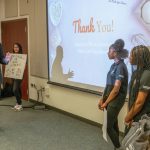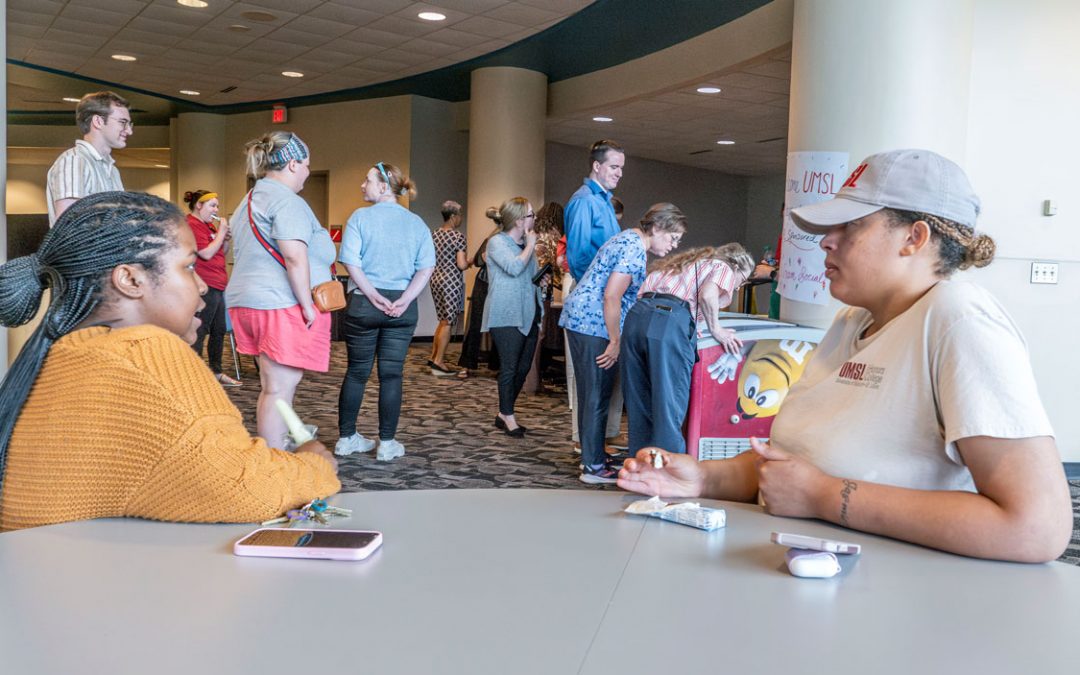When it comes to Joseph Carroll’s latest book, the development of the title alone sounds like an arduous process – yet also oddly appropriate given the volume’s subject matter and breadth.
“The discussion went on for several days, with hundreds of emails debating aspects of the title,” says Carroll, Curators’ Professor of English at the University of Missouri–St. Louis and co-editor of the new volume “Darwin’s Bridge: Uniting the Humanities & Sciences” from Oxford University Press. “Eventually we reached consensus.”

“Darwin’s Bridge: Uniting the Humanities & Sciences” (Oxford University Press, 2016) is co-edited by UMSL faculty member Joseph Carroll and draws many of its essays from the Consilience Conference held at UMSL in 2012. (Images courtesy Joseph Carroll)
Hot off the press just a few months ago, the title on the cover still turned out different from what the editors and writers had discussed at such length.
“Oxford UP accidentally switched the order of the words ‘Science’ and ‘Humanities’ in the subtitle and then asked if it was OK to leave it that way,” Carroll explains. “I didn’t mind. ‘Humanities’ now comes first. Possibly a few humanities professors will be mollified at not coming second.”
An exercise in interdisciplinary collaboration from start to finish, the book features the work of 21 wide-ranging contributors. Many of them spoke at a conference hosted by UMSL four years ago, including the world-renowned biologist E. O. Wilson, who served as co-editor alongside Carroll and Dan McAdams.
UMSL Daily recently caught up with Carroll about the new volume of essays as well as his new role as editor-in-chief of “Evolutionary Studies in Imaginary Culture,” a newly launched academic journal.
Briefly, how did “Darwin’s Bridge” come about? Did you and others have it in mind even before the Consilience Conference here on campus four years ago, or did it develop as an idea after the event?
As we were planning the conference, I had already thought about possibly publishing a volume of essays from it. A couple of the contributors, Barb Oakley and Dan McAdams, had previously published books with Abby Gross, a psychology editor at Oxford University Press. They wrote letters to her recommending she look at the volume. Some of the participants in the conference did not produce chapters, and we added a couple of contributors who weren’t at the conference but who write in the spirit of the conference.
I’m also curious what it was like to work with E. O. Wilson.
E. O. Wilson is magnanimous, courteous and reasonable. It is a pleasure to work with him.
The book’s subtitle, “Uniting the Humanities & Sciences,” immediately makes me think of efforts toward more interdisciplinary work within academia. Can you give a specific example or two from the book where traditionally disparate ideas come together in a fruitful way?
Yes, it is definitely an interdisciplinary volume. The contributors include biologists, geneticists, anthropologists, psychologists, literary scholars, a philosopher, an art theorist and an engineer.
One of the psychologists, Dan McAdams, deals with the life stories real people construct about themselves – true stories (more or less true, anyway) in which they are themselves the main characters. In a chapter I co-authored with another literary scholar and two psychologists, we use ideas from evolutionary anthropology and psychology to analyze stories about fictional characters. Brian Boyd uses cognitive science to discuss Shakespeare sonnets and graphic narratives. Barb Oakley works out a program for integrating psychology with engineering. John Hawks, who is an anthropologist, and Ellen Dissanayake, who is an art theorist, both discuss ancient rock art.
As chief editor for the new journal “Evolutionary Studies in Imaginative Culture,” what’s your overall vision for that publication? And what sorts of submissions have come in so far?
We are going to publish scholarly and scientific articles and reviews on every aspect of imaginative culture: literature, film, theater, television, music, religion, the visual arts, video games, graphic novels, comics, fads and fashions, hobby groups, sports cultures, creative nonfiction, and the imaginative manifestations of politics, ethnicity, ideology, religion, and other forms of group identity. Contributors to the journal will explain and interpret such subjects using ideas from the evolutionary human sciences – evolutionary anthropology, evolutionary psychology, evolutionary sociology and evolutionary political science.

Curators’ Professor of English Joseph Carroll has been named editor-in-chief of a new academic journal, “Evolutionary Studies in Imaginative Culture,” which will publish its first issue in the spring of 2017.
We won’t know for another month or so what articles will be submitted for the first issue, but prospective contributors have offered topics such as superheroes, urban legends, dreams, the evolution of music, ethnic conflict, literary theory, science fiction, American realist fiction and neuroaesthetics (how the brain is wired to perceive beauty and ugliness). For this first issue, we are also including reviews of more than two dozen recent books in the evolutionary human sciences and the evolutionary humanities.
“Imaginative culture” is a new term to me. Is that just me, or is it something more recently coined?
I’ve been using the term for several years but don’t know whether I coined it or not. It is not as yet a widely used term. “Culture” is shared knowledge passed on through social learning. That kind of knowledge includes technology, all crafts and skills, and socioeconomic and political traditions. Those are practical forms of culture. “Imaginative culture” is what goes on in the mind, the meaning and value we attribute to things, the symbols, narrative structures and aesthetic forms we use to make sense of human motives and feelings. Imaginative culture is ultimately the vision people have of the world – a vision that is emotionally charged and aesthetically shaped.
Despite these and other developments within evolutionary literary theory, you have noted previously that within academic literary circles you and likeminded scholars “constitute a small and embattled minority.” If asked by a layperson why you think that is the case, what would you tell them, in a nutshell?
Humans have an innate tendency to divide the world into two parts: a physical part and a mental part. Traditionally, the physical part has been the province of science. The mental or imaginative part has been the province of the humanities. Most humanists don’t think the imaginative world can be known by science, and they certainly hope it can’t. They are intimidated by science, resentful at its power and influence, and afraid that what they hold as sacred, or at least as politically correct, will somehow be diminished or nullified by science.
They live out or perform or enact the emotional and imaginative subjects of the humanities. They shudder to think that it could all be reduced to physics, chemistry and biology. Many of them don’t like math and aren’t very good at it. Then, too, they take great satisfaction in striking ideological poses. A scientific orientation to a subject discourages ideological poses.
In what ways do you see your research impacting your teaching here at UMSL?
I teach courses in literary theory and have steadily integrated more evolutionary theory into that. For many years, I’ve taught one course a year in the Pierre Laclede Honors College, which encourages interdisciplinary courses. I’ve often made up courses that intertwine with my research.
The book project I’m working on is called “The Truth About Fiction: Biological Reality and Imaginary Lives.” I teach a version of that in the honors college, and the ideas in it enter also into courses about fiction I teach in the English department – courses on 19th-century British fiction, short stories in world literature and novels adapted to film.














